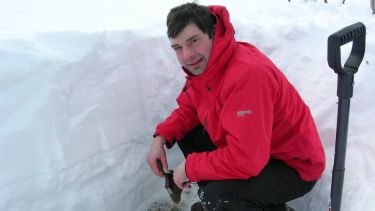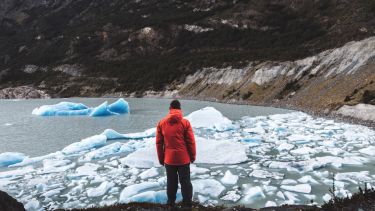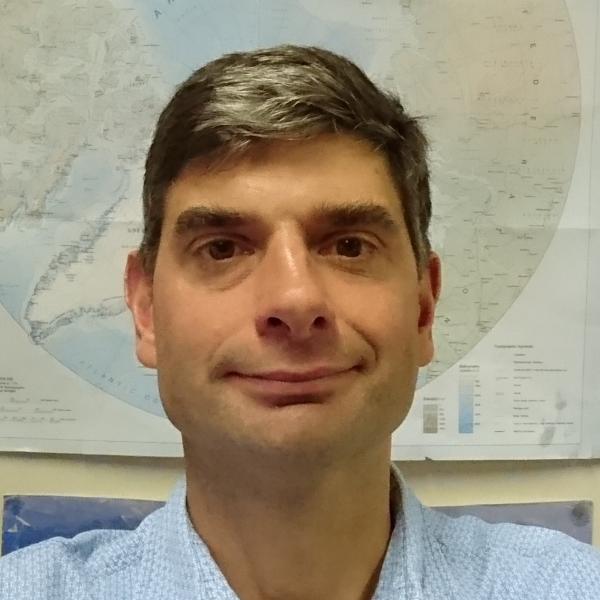Understanding the Arctic
The Arctic covers 14.5 million square kilometers of the earth’s surface but we know relatively little about it. To understand its potential influence on climate change we need to be able to research all of it, from Sweden to Siberia. So how do you connect such a vast, scientifically unknown region?

Turning the Arctic brown
Gareth has been visiting Abisko, in the Arctic circle of Sweden, for years. He’s been there in the depths of winter when the snow is several feet deep, and in the height of summer when mosquitos are buzzing around every person (and reindeer) in sight. If there’s one thing he’s learnt from his years of research in the Arctic circle, it’s to be prepared for extremes.
Gareth Phoenix, a Professor at the University of Sheffield, studies Arctic ecosystems. In particular, the impacts of climate change on the ecosystem structure and function. The Arctic is vast and the changes occurring here — retreating glaciers, melting permafrost and shrinking ice caps — have the potential to dramatically impact the rest of the world. Despite this, from a scientific point of view, much of the Arctic is unexplored, undiscovered and unknown. One thing we know for certain is that for approximately 35 years it has seen increasing growth of vegetation — a process known as ‘Arctic greening’. However, now it looks as though some of it might actually be turning brown.
When satellites in space detect plants on Earth they measure the ‘greenness index’, in other words, how green the ground cover of plants is. How lush the foliage on the ground appears from space can represent a number of aspects down on earth, from plant growth to leaf area. But if areas of the Arctic are browning, it may indicate something else as well: plant death.
The plant death is a result of extreme weather events, which are becoming more frequent in the Arctic as the climate warms. A sudden period of warmth tricks the plants into thinking it’s spring, so they burst bud early and lose their cold hardiness, leaving them unprepared for a return to normal cold winter temperatures.
Professor Gareth Phoenix, the University of Sheffield
While conducting research at the Abisko Scientific Research station, one of the leading centres for Arctic research, Gareth considered the increase in extreme winter warming events and the impact they might be having on the ecosystem and climate change. He approached his colleague Professor Terry Callaghan, to see if they could measure the impacts of extreme winter warming on plants to better understand their consequences on an ecosystem and global level.
At the time, Terry directed the Abisko Scientific Research Centre and encouraged Gareth to collaborate with a Norwegian scientist, Jarle Bjerke, who also expressed an interest in the impacts of these extreme events. As the team had access to Abisko’s research facilities, they were able to experimentally manipulate plants in this region of the Arctic to see what the effect of extreme winter warming was.
The process involved simulating extreme winter warming events by heating areas where vegetation would normally grow and then reverting it back to normal winter temperatures to see how plants responded. What began as a conversation between Gareth and Terry transformed into research that was the first of its kind. The team discovered the devastating effects that extreme winter warming was having on the Scandinavian Arctic, where whole landscapes can become filled with dead plants.
But what about the rest of the Arctic? Satellite data suggested a browning across the Arctic, but it’s difficult to know exactly what’s happening without experimental testing at the ground level. “If satellites detect plants having a lower greenness index we don’t always know why that’s the case. It could be that the plants have died, or maybe they’ve just grown less. There could also be patches of some species dying and others not dying which results in a lower overall greenness index,” explains Gareth. It’s important to know what’s happening at the ground level across the Arctic to understand how the ecosystem and the climate is going to be impacted.
A collaborative approach
Gareth and Terry have conducted research across the Arctic, not just in Abisko, and, like most Arctic researchers, they know all too well the difficulties associated with conducting research in this region. Researchers can be trapped in tents while icy blizzards rage for days on end and temperatures reach as low as -50 degrees celsius, but it’s not always this extreme. Sometimes research is carried out from a comfortable research station a few kilometers away from the nearest town. Of course all of this is assuming you can get to the site of your research in the first place, which is no mean feat given the difficulties posed by travelling to Arctic regions. Huge distances, unpredictable weather and a lack of infrastructure all make transporting researchers and their equipment an expensive challenge.
Terry identified this problem and developed INTERACT as a route to improving access to Arctic research centres, as well as increasing collaboration between research scientists. Set up by Terry in 2010 and now the world’s largest Arctic research network, INTERACT has one goal: to understand the environmental variation across the Arctic, from the evergreen forests to the barren, frozen alpine regions.
Professor Terry Callaghan, the University of Sheffield
Say you’re a researcher, like Gareth, looking at Arctic browning. You’re stuck working in Abisko but you need to know the greenness index of several regions in other Arctic countries — in other words how lush and green an area is. INTERACT funds a person at the research station you need data from to collect that data for you, as a form of remote access. And suddenly, you have all the data you need to complete your study, from all the research stations you need it from — without ever having to leave your own research station.
INTERACT currently has more than 70 research stations around the world collaborating in this way. “Research should be about who you work with in a way that facilitates access and networking to improve scientific research,” explains Terry. As well as remote access, it’s allowing researchers from different stations to travel easily to other international centres to conduct research, which INTERACT funds. “Every year the stations together host around 5,000 scientists and facilitate the work of 156 international networks,” says Terry. And one region where such access is hugely beneficial is Siberia.
Uniting the rest of the Arctic
Siberia makes up a significant proportion of the Arctic. However, due to access difficulties and political circumstances, it’s a region many Arctic researchers can only dream of accessing. “As a British scientist the main way you could work in Siberia is if you had a personal relationship with a Siberian scientist and you could go and work closely with them,” says Gareth. But it’s not just outside collaborations that are difficult. The huge distances involved in getting from one region of Siberia to the other also make collaboration between Siberian scientists challenging.
Western scientists and Siberian scientists alike want to understand Siberia. It’s a massive part of the Arctic and we know very little about it. To address this, Terry, using the knowledge he’d built up from his success with INTERACT, developed SecNet, the Siberian environmental change network. While still in its infancy, SecNet is contributing to Arctic research and helping to develop our understanding of how the Arctic is impacting climate change. “I think ultimately, by bringing scientists, policy makers and indigenous people together it [SecNet] should hopefully start to provide a much better understanding of the key environmental challenges facing Siberia and much of the Arctic,” says Gareth.
Thanks to the organisations Terry has founded, conducting Arctic research and understanding its implications for the climate is becoming ever easier. Gareth now has opportunities to collect browning data from research stations thousands of kilometers away. For Gareth,
This new form of access could be a real solution to enhancing our understanding of what's happening in the Arctic
Professor Gareth Phoenix
The University of Sheffield
Further information
Arctic browning: impacts of extreme climatic events on dwarf shrub heathland ecosystem CO2 fluxes
INTERACT - stories of Arctic Science





